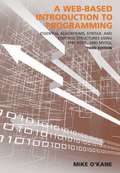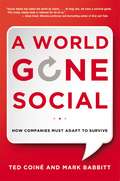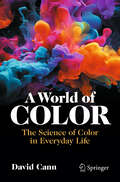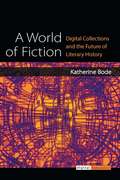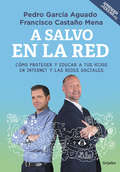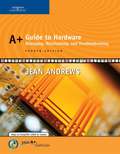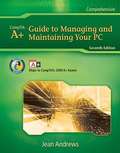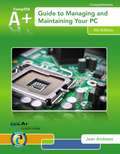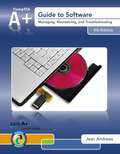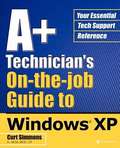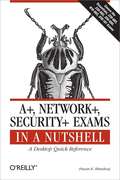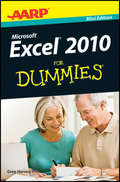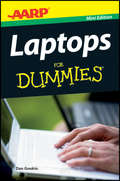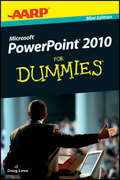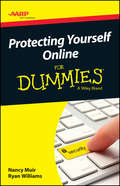- Table View
- List View
A Vulnerable System: The History of Information Security in the Computer Age
by Andrew J. StewartAs threats to the security of information pervade the fabric of everyday life, A Vulnerable System describes how, even as the demand for information security increases, the needs of society are not being met. The result is that the confidentiality of our personal data, the integrity of our elections, and the stability of foreign relations between countries are increasingly at risk.Andrew J. Stewart convincingly shows that emergency software patches and new security products cannot provide the solution to threats such as computer hacking, viruses, software vulnerabilities, and electronic spying. Profound underlying structural problems must first be understood, confronted, and then addressed.A Vulnerable System delivers a long view of the history of information security, beginning with the creation of the first digital computers during the Cold War. From the key institutions of the so-called military industrial complex in the 1950s to Silicon Valley start-ups in the 2020s, the relentless pursuit of new technologies has come at great cost. The absence of knowledge regarding the history of information security has caused the lessons of the past to be forsaken for the novelty of the present, and has led us to be collectively unable to meet the needs of the current day. From the very beginning of the information age, claims of secure systems have been crushed by practical reality.The myriad risks to technology, Stewart reveals, cannot be addressed without first understanding how we arrived at this moment. A Vulnerable System is an enlightening and sobering history of a topic that affects crucial aspects of our lives.
A Web for Everyone
by Whitney Quesenbery Sarah HortonIf you are in charge of the user experience, development, or strategy for a web site, A Web for Everyone will help you make your site accessible without sacrificing design or innovation. Rooted in universal design principles, this book provides solutions: practical advice and examples of how to create sites that everyone can use.
A Web-Based Introduction to Programming (Third Edition): Essential Algorithms, Syntax, and Control Structures Using PHP, HTML, and MySQL
by Mike O'KaneA Web-Based Introduction to Programming is designed for use in introductory programming, programming logic and design, or Web programming courses, and for anyone seeking a painless way to learn the basics of programming by developing small Web applications. It keeps the focus on the need for beginning programmers to learn essential syntax and control structures with minimal complexity.
A World Gone Social: How Companies Must Adapt to Survive
by Ted Coiné Mark BabbittThe Social Revolution's impact on the business world cannot be over-estimated. Like the meteor that likely precipitated the end of the dinosaurs, Social is the catalyst in an extinction event--and business as we know it has changed forever. A World Gone Social offers an eye-opening look at fundamental and powerful changes the social collaboration era has set in motion: Customers now have the power--just watch what happens as more realize it! With increased transparency, businesses must be more ethical--no more pretending Command-and-control leadership is now so inefficient, it is a liability Nimble and small is the new competitive advantage--few corporations are capable of the agility required by evolving marketplaces Recruiting is now a two-way proposition, with job seekers able to peer behind the corporate curtain Relationship and community-building is how customers and brand ambassadors are won--and retained Engagement--with partners, employees, and customers--is not a luxury; it is a requirement. Each chapter provides compelling stories and concrete examples of companies demonstrating enlightened business practices and doing Social right--and some that are not--and the lessons to be learned from their experiences. Finally, readers will discover how to objectively assess the fit ness of their own company's culture and social presence. . . so they may successfully transition from a 20th- to a 21st-century "social" organization.
A World of Color: The Science of Color in Everyday Life (Copernicus Books)
by David CannThis book demystifies the intricate science behind the colors that surround us every day, making it accessible to readers of all backgrounds, from the crackling warmth of campfires to the iridescent glow of butterfly wings. Have you ever wondered why the sky appears blue, or why leaves turn golden in the fall? How do our eyes perceive color, and why do some creatures see the world in hues we can only imagine? Delve into the captivating world of color with this informative and engaging book as your guide. A rich assortment of colorful figures and photographs accompanies you on a journey from the tranquil depths of the ocean to the shimmering neon lights of the urban cityscape. You'll learn how things like fluorescence, refraction, and interference allow artists to manipulate color to evoke emotion, and how scientists harness it to revolutionize technology. How does the color of fireflies inspire cutting-edge display devices, and what can the mantis shrimp teach us about the evolution of color vision? Prepare to be dazzled as you embark on a journey through the spectrum of discovery. Are you ready to see the world in a new light?
A World of Fiction: Digital Collections and the Future of Literary History (Digital Humanities)
by Katherine BodeDuring the 19th century, throughout the Anglophone world, most fiction was first published in periodicals. In Australia, newspapers were not only the main source of periodical fiction, but the main source of fiction in general. Because of their importance as fiction publishers, and because they provided Australian readers with access to stories from around the world—from Britain, America and Australia, as well as Austria, Canada, France, Germany, New Zealand, Russia, South Africa, and beyond—Australian newspapers represent an important record of the transnational circulation and reception of fiction in this period. Investigating almost 10,000 works of fiction in the world’s largest collection of mass-digitized historical newspapers (the National Library of Australia’s Trove database), A World of Fiction reconceptualizes how fiction traveled globally, and was received and understood locally, in the 19th century. Katherine Bode’s innovative approach to the new digital collections that are transforming research in the humanities are a model of how digital tools can transform how we understand digital collections and interpret literatures in the past.
A salvo en la red
by Francisco Castaño Mena Pedro García AguadoDe la mano de Pedro García Aguado y Francisco Castaño Mena llega el tercer volumen del proyecto «Aprender a educar», centrado esta vez en un tema tan preocupante, complejo y actual como el modo en que debemos proteger a nuestros hijos en internet y las redes sociales. <p><p>¿Cuándo debo comprarle un smartphone a mi hijo? ¿Tengo que establecer unas normas de uso? ¿Cómo le protejo de los riesgos de internet? ¿Cómo controlo que no sufra o haga ciberbullying? Desde su proyecto «Aprender a educar», Pedro García Aguado y Francisco Castaño Mena hacen hincapié en la educación familiar como factor clave de protección para prevenir posibles dificultades con los hijos. En este tercer libro, los autores se adentran en las nuevas tecnologías y muestran a padres y profesores cómo educar en su uso. <p>A salvo en la Red es un manual indispensable para que niños y adolescentes reciban una buena educación digital y les enseñemos a utilizar estas herramientas sin riesgo y sacándoles el máximo partido. Con un lenguaje directo y cercano, los autores nos exponen casos reales de su consulta y nos enseñan que las nuevas tecnologías, usadas de forma correcta, pueden convertirse en grandes aliadas.
A+ Guide to Hardware: Managing, Maintaining And Troubleshooting (Sixth Edition)
by Jean AndrewsNIMAC-sourced textbook
A+ Guide to Hardware: Managing, Maintaining, and Troubleshooting
by Jean AndrewsNIMAC-sourced textbook
A+ Guide to Managing and Maintaining Your PC
by Jean AndrewsWritten by best-selling author and instructor Jean Andrews, this edition maps fully to CompTIA's new 2006 A+ Exam objectives. This full-color guide is designed to be the most complete, step-by-step book available for learning the fundamentals of supporting and troubleshooting computer hardware and software. Video clips are available on the accompanying CD so readers can watch the author bring concepts and technical topics to life via live demonstrations.
A+ Guide to Managing and Maintaining Your PC
by Jean AndrewsWritten by best-selling PC repair author and educator Jean Andrews, the seventh edition of A+ Guide to Managing and Maintaining Your PC maps fully to CompTIA's 2009 A+ Exam objectives. This full-color guide is the most complete, step-by-step book available for learning the fundamentals of supporting and troubleshooting computer hardware and software. At the same time, it prepares readers to successfully pass the A+ 220-701 and 220-702 exams. The new edition is formatted to support any teaching or learning style and course format, featuring an essentials-to-practical organization within each chapter and inclusion of tabs distinguishing exam content. Further content and live demonstrations with Jean Andrews are available on the accompanying CD, making this new edition a total solution for PC repair.
A+ Guide to Managing and Maintaining Your PC (7th edition)
by Jean AndrewsWritten by best-selling PC repair author and educator Jean Andrews, the seventh edition of A+ Guide to Managing and Maintaining Your PC maps fully to CompTIA's 2009 A+ Exam objectives. This full-color guide is the most complete, step-by-step book available for learning the fundamentals of supporting and troubleshooting computer hardware and software. At the same time, it prepares readers to successfully pass the A+ 220-701 and 220-702 exams. The new edition is formatted to support any teaching or learning style and course format, featuring an essentials-to-practical organization within each chapter and inclusion of tabs distinguishing exam content. Further content and live demonstrations with Jean Andrews are available on the accompanying CD, making this new edition a total solution for PC repair.
A+ Guide to Managing and Maintaining Your PC, Comprehensive
by Jean AndrewsThis step-by-step, highly visual text provides a comprehensive introduction to managing and maintaining computer hardware and software. Written by best-selling author and educator Jean Andrews, A+ GUIDE TO MANAGING AND MAINTAINING YOUR PC closely integrates the CompTIAA+ Exam objectives to prepare you for the 220-801 and 220-802 certification exams. The new Eighth Edition also features extensive updates to reflect current technology, techniques, and industry standards in the dynamic, fast-paced field of PC repair. Each chapter covers both core concepts and advanced topics, organizing material to facilitate practical application and encourage you to learn by doing. Supported by a wide range of supplemental resources to enhance learning--including innovative tools, interactive exercises and activities, and online study guides--this proven text offers an ideal way to prepare you for success as a professional PC repair technician.
A+ Guide to Managing and Maintaining Your Pc
by Jean AndrewsThis step-by-step, highly visual text provides a comprehensive introduction to managing and maintaining computer hardware and software. Written by best-selling author and educator Jean Andrews, A+ GUIDE TO MANAGING AND MAINTAINING YOUR PC closely integrates the CompTIAA+ Exam objectives to prepare you for the 220-801 and 220-802 certification exams. The new Eighth Edition also features extensive updates to reflect current technology, techniques, and industry standards in the dynamic, fast-paced field of PC repair. Each chapter covers both core concepts and advanced topics, organizing material to facilitate practical application and encourage you to learn by doing. Supported by a wide range of supplemental resources to enhance learning--including innovative tools, interactive exercises and activities, and online study guides--this proven text offers an ideal way to prepare you for success as a professional PC repair technician.
A+ Guide to Software: Managing, Maintaining, And Troubleshooting (Sixth Edition)
by Jean AndrewsNIMAC-sourced textbook
A+ Technician's On-the-job Guide to Windows XP
by Curt SimmonsOffers optimization and troubleshooting tips and solutions, organized by topic. This guidebook helps to diagnose and fix Windows XP problems. It is meant as an on-the-job companion, featuring information in a step-by-step, and task-oriented format.
A+, Network+, Security+ Exams in a Nutshell: A Desktop Quick Reference
by Pawan K. BhardwajIf you're preparing for the new CompTIA 2006 certification in A+, or the current Network+ and Security+ certifications, you'll find this book invaluable. It provides all the information you need to get ready for these exams, including the four new A+ exams -- the required Essentials exam and three elective exams that pertain to your area of specialization.As with other O'Reilly Nutshell books for certification exams, A+, Network+ and Security + in a Nutshell follows a proven style and approach. It reviews all of the topics needed to master each exam in a remarkably concise format, with required knowledge boiled down to the core. Instead of plowing through 500 to 700 pages to prepare for each exam, this book covers each one in approximately 150 pages. And because the objectives for the three elective A+ exams are redundant, and the book covers them in one section.The exams covered include:A+ Essentials: Required for A+ 2006 certificationEXAM 220-602: For the A+ IT Technician specializationEXAM 220-603: For the A+ Remote Support Technician specializationEXAM 220-604: For the A+ IT Depot specializationEXAM N10-003: For Network+ CertificationEXAM SYO-101: For Security+ CertificationEach exam is covered in three parts: Exam Overview, Study Guide and Prep and Practice. Plenty of detailed tables and screen shots are included, along with study notes and practice questions. Once you have completed the exams successfully, you will find this all-in-one book to be a valuable reference to core administration and security skills.
A11Y Unraveled: Become a Web Accessibility Ninja
by Dimitris GeorgakasMake designing and developing accessible websites fun and straightforward by deciphering information that is often confusing. This book examines how web professionals can ensure a website is as accessible as it can be, meeting the needs of its audience. The main focus is on web accessibility and, WCAG 2.1 and 2.2 guidelines: what they are, who they are for, and what can be done from a design point of view to make the lives of the users easier. In reviewing the fundamentals, emphasis will be given on what disabilities could potentially prevent users from getting the information they need and what can be done to help them. This is achieved by breaking down web design and development terms and practices, such as web accessibility, color contrast, typography, how to design specific components like carousels, forms, and so on. Each chapter features design examples presented in a clear and concise manner. Each design element is divided into different components, highlighting exactly what helps with what, showing how a website needs to be designed for the benefit of its people. A11Y Unraveled also reviews the current laws and legislations that govern web accessibility in different parts of the world.What You'll LearnDiscover how people perceive information on the web, and how that might create barriers in communication.Review different disabilities or limitations that prevent users from accessing web information and how to address them.Design an accessible website for specific disabilities through practical examples.Understand how different web design components affect the user.Study current web accessibility legislation, avoiding difficult to understand lingo.Who This Book Is ForMain audience would be digital and web professionals (mainly designers but developers can benefit as well). It can also help business owners who want to ensure their websites are adhere to accessibility standards.
AARP Excel 2010 For Dummies
by Greg HarveyCrunch numbers the easy way with Excel 2010 This handy mini guide is packed with the information you need to become a spreadsheet superstar! You’ll learn to find your way around Excel 2010, enter data on a worksheet, create simple formulas, format cells, preview and print pages, and more. Whether you’re new to Excel 2010 or new to Excel altogether, the basics are all here. Open the book and find: Ten cool Excel 2010 features How to navigate the Ribbon A guide to formatting cells Where to turn for online help How to make your spreadsheets look the way you want
AARP Facebook
by Marsha CollierConnect with old friends and make some new ones with Facebook and this one-of-a-kind referenceAARP Facebook: Tech to Connect is packed with examples and guidance to familiarize you with Facebook and all it has to offer. People over 55 are among Facebook's fastest-growing user segment, with well over six million users, and this guide shares the insights of many 50+ users. It covers signing up, creating a profile, adding friends, posting status updates, chatting online, uploading photos and video, creating events, joining groups, and much more.Covers creating and tweaking a profile, finding and adding friends, creating events and groups, subscribing to news feeds, creating status updates, and sending messages to friendsExplains how to become a fan, play social games, add and manage applications, post notes, share links, add and tag photos, and adjust privacy optionsFeatures task-oriented tutorials arranged in such a way to make it easy to find material and achieve successYou might as well face it. You'll love Facebook, and this guide is filled with the essentials you need to enrich your experience and have some Facebook fun.
AARP Laptops For Dummies
by Dan GookinTake technology with you wherever you go! Get a move on and learn to roam free with this mini guide to choosing and using a laptop. Packed with useful advice on picking a laptop, setting it up, managing power and peripherals, going online, and hitting the road, you’ll learn to love your laptop with help from For Dummies. Whether this is your first laptop or a recent upgrade, you’ll get the advice you need from laptop to lap-bottom here. Open the book and find: Tips for buying the right laptop for you A tour of your laptop and its features Explanations of common laptop terms Maintenance and troubleshooting tips How to connect to a wireless network
AARP Outlook 2010 For Dummies
by Bill DyszelGain a whole new outlook on e-mail Overwhelmed by e-mail and ready to simplify your inbox? You’ll be surprised at all the things you can accomplish with this mini guide to effectively using Outlook 2010. From creating notes, managing e-mail, and maintaining your calendar to eliminating spam and tracking your schedule, you’ll take back control of your inbox and stay organized with Outlook 2010 and help from For Dummies. Open the book and find: Tips for setting up the Navigation pane Easy e-mail essentials Steps for storing names and addresses How to use the Outlook calendar Ways to reduce spam
AARP Pinterest For Dummies
by Kelby CarrGet on board and join in the fun with Pinterest! This handy mini guide walks you through the basics of Pinterest, the immensely popular virtual pinboard that lets you share your inspirational ideas online. You’ll learn how to request an invite, set up your account, create and edit boards, and start pinning your favorite images today! Open the book and find: Tips on setting up your Pinterest profile Help creating your own pinboards Advice on finding friends and sharing pins Secrets for creating quality pins How to give credit where credit is due
AARP PowerPoint 2010 For Dummies
by Doug LoweAdd some pizzazz to your presentations Slideshows are one of the best ways to captivate your audience during a presentation, and this one-of-a-kind mini guide will show you how to build great-looking slides, add sound and video, animate your slideshow graphics, and more. Whether you're showing off pictures from your summer vacation or trying to raise money for your favorite cause, PowerPoint 2010 is sure to add the power you need to all your presentations. Open the book and find: What's new in PowerPoint 2010 Tips on navigating the Ribbon How to create and edit a slide presentation Hints for working in Backstage View How to set up a presentation
AARP Protecting Yourself Online For Dummies
by Nancy C. Muir Ryan C. WilliamsProtect your privacy and use the internet safely! Don’t let news about internet risks deter you from taking full advantage of its benefits! The web is such an amazing and useful resource for connecting with friends and family, shopping, banking, catching up on current events, and getting help in a myriad of ways. Let AARP’s Protecting Yourself Online For Dummies arm you with the information you need to use the internet with confidence. You’ll learn: How and why risks can occur Steps to protect yourself from identity theft, fraud, and e-mail scams Expert tips for creating strong passwords and storing them safely Information you need to keep your online banking and shopping accounts safe By reading this guide and following a few safety precautions, you can be confident and risk-free as you enjoy a connected, digital life online!


